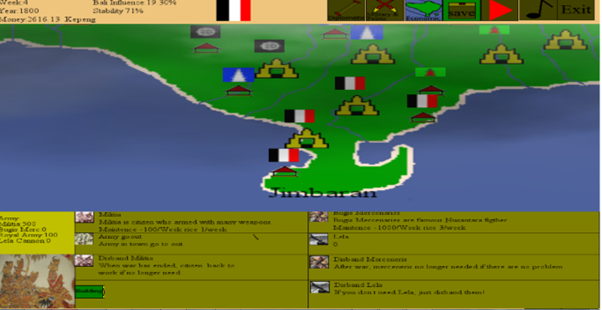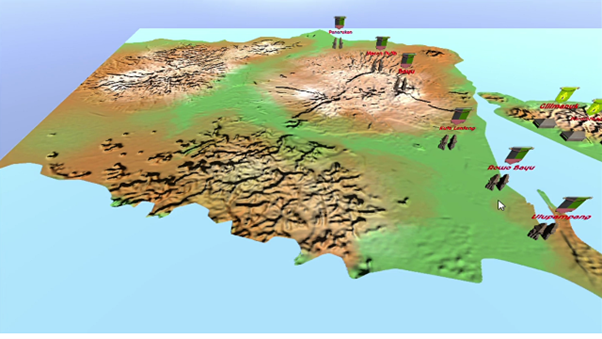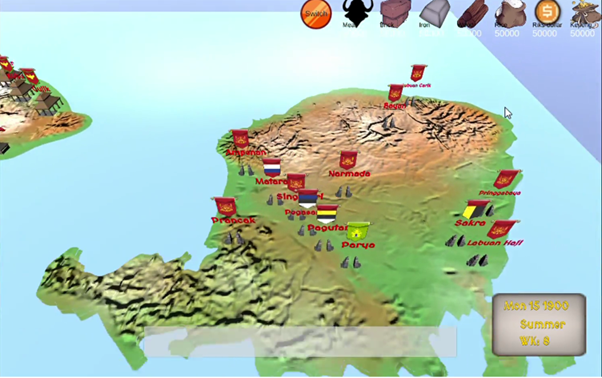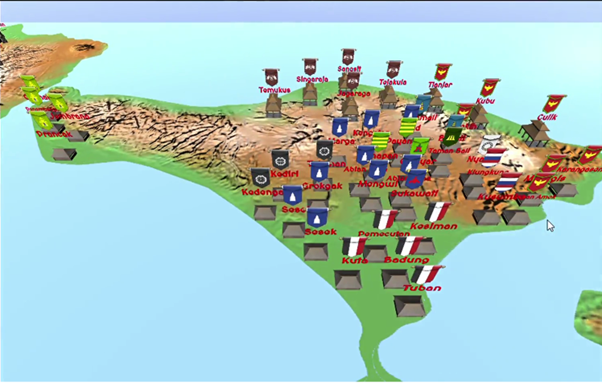Fall of Bali is a historical strategy game set in Bali in the 18th and 19th centuries, when Balinese kingdoms fought each other, their rivalry having started when the Gelgel Empire dissolved in 1686 and made many vassals independent.
The game allows players to control, manage, and build one of the Balinese kingdoms in this era, starting in 1767 and ending in 1908. 1767 is the year when Blambangan, a vassal of Mengwi, a great Balinese kingdom, was attacked by the Dutch East India Company (VOC), which received rights to the East Java frontier from Pakubowono II in 1743 and treated with the English East India Company (EIC) which was reported active in Strait of Bali and Blambangan. 1908 was the year when the king and royal Klungkung family conducted a ‘puputan’ or suicide attack on Dutch troops.
The Fall of Bali development process started in June 2022, with a rough idea to remake the old version Fall of Bali and now, on 30 November 2022, Fall of Bali is in the prototype phase and hopefully will enter alpha soon. The old version Fall of Bali was developed using GameMaker Studio 1.4, between 6 November 2015 and early January 2017, and marked the first Sengkala Dev game. What’s distinguishes the new version of Fall of Bali from the old one, besides the fact that we now use Unity for 3D mapping and units, is that the new version offers many new features, including more historical information than previously and much better gameplay. The aspect of Fall of Bali that I want to focus on here, though, is population.
In the old version of Fall of Bali, the game started in the year 1800 and ended in 1908. The population in Bali and Lombok was not much of a concern, although I, as the game director of Sengkala Dev who did the programming and art, have done much research about the Balinese realm at that time for gameplay content. At that point, the gameplay was still simple: build, prepare troops, and go to war. Now it’s different, as the scale of Fall of Bali has expanded.

From my experience in developing Perang Laut-Maritime Warfare (2017-2019, 2021) and Dato of Srivijaya (2020), accurate historical information about population became a problem, especially in Srivijaya’s era (7th century to 10th century). In Perang Laut-Maritime Warfare, the biggest port city probably had a large population like that in Mallaca, Aceh and Makassar, of more than 50,000 people during Srivijaya’s era, but the population was generally still low, especially in Sumatra. Sumatra at that time had mass jungle areas around the mountains in the Bukit Barisan range (from which a lot of gold comes). The population concentrated in several places, such as in East Sumatra near the Strait of Mallaca, and several kingdoms were established, such as the Kingdom of Malay, which was later annexed by Srivijaya in the late 7th century. On the west coast of Sumatra was an important port known as Fansur or Barus, now located in North Sumatra province, where camphor was produced. Barus was very important at that time, meaning a large population was based there.
Population can effect many things, including castes, taxes, buildings, birth rates, death rates, and troops when war comes. And in the new version, the game area not only covers Bali, but also the Lombok islands and Blambangan, the eastern point of Java. Both areas were under Balinese influence for several centuries. The population in these areas was quite different, since in Lombok, the natives of Lombok are the Sasak, who live in central and eastern Lombok, while Balinese live in west Lombok. In Blambangan, there are Osiang who have a different language from the Javanese and Balinese.
In one week, I tried to establish the population in Bali by reading journals and search online. At first, I worked with Balinese population numbers from the Dutch colonial census, the volkstelling, from the 1930s and searched for the formula used to calculate population growth. I found some formulas which allowed me to calculate a population for 1767. Later, however, I found Thomas Raffles’ data about the Balinese population in 1815. Raffles was Lieutenant Governor of East India after the British conquered Java in 1812 and the British controlled the administration of the Indonesian archipelago, although they not control Bali. Raffles indicated that the Balinese population sat around 806,250 people in 1815. This number rather surprised me, since I had thought the number of Balinese was probably some 500,000 people. So, I converted it with my formula to calculate the population of Balinese:
Population in 1767 = Population in 1815/((1+ population growth rate)*1815-1767)
I assumed the population growth rate in Bali was very low, at around 0.016% per year, as the Balinese at that time faced many problems from war, slavery, and disease. This was not only happening in Bali but in most islands in the Indonesian archipelago at that time in the early 19th century.
In Fall of Bali, there are four possible starting years – 1767, 1771, 1778, and 1780 – based on the appearance of new kingdoms. In 1767, most playable kingdoms already existed. In 1771, the Gianyar officially become a kingdom with the establishment of Gianyar’s Puri or Palace. In 1778, the Kingdom of Badung established Denpasar’s Puri or Palace, reckoned as the starting point of Badung. And in 1780, the Kingdom of Sakra, Sasak’s kingdom, appears in the history of Lombok. And so a new challenge came to me: how large was the population in Blambangan and Lombok at that time?

Before I explain more, I must tell you what Blambangan is. Blambangan was the last Hindu kingdom in Java in the mid-17th century. Balinese kingdoms used Blambangan as a buffer against the Sultanate of Mataram and the influence of the VOC. Blambangan was defeated by Mataram in 1640 during the reign of Sultan Agung, and claimed as a Mataram region, but was never actually controlled as first Buleleng and then Mengwi used Blambangan as a fortification against the threat of Bali. The VOC obtained the rights to Blambangan from Pakubowono II, ruler of Mataram, in 1743 after it helped Mataram against Java and Chinese rebels in the Java War of 1741-1743. By 1767, the VOC had not yet taken control of Blambangan and, after some investigation into the EIC’s activity in Blambangan and Strait of Bali, the VOC decided to attack Blambangan.
Blambangan changed rapidly between 1767 and 1773, as war against the VOC resulted in many people fleeing to the hinterlands or dying in battle against VOC troops in order to defend their honour. Around two-thirds of the population perished, so the population in 1771, 1778, and 1780 was very different from the population in 1767. The VOC attempted to recover the population in Blambangan through several means, including migration of Madurese from Madura, but was unsuccessful and eventually gave a promise of safety to Blambangan refugees to allow them to return to their villages.
From Sri Margana’s dissertation about Blambangan in this era, I estimated the population of Blambangan at about 39,000 people in 1767, since Raffles estimates around 80,0000 people lived there in 1750 and this number has fallen to only 8,000 in 1811. In further research, Sri Margana explained that, in 1772, according a report from Governor General Van der Parra in November of that year, the population in eastern Blambangan was only 2,503 people, a mere 8.3% of the previous population (30,157 people). I assumed the population in Blambangan before the war was 39,000 since Panarukan, the port city of the Java frontier, was included on the Blambangan map.

For Lombok’s population, I could not find any sources. Lombok at that time was divided into 4 kingdoms ruled by relatives of a large family of Karangasem, with Singhasari the biggest kingdom ruling Balinese (Hindu) and Sasak (Moslem). Searching in the Dutch colonial volkstelling proved difficult but when I read a journal about Tambora’s eruption in 1815, I found some data about Lombok’s population at that time: about 200,000 in 1815 before the eruption and, according to Van der Broek, the Dutch commissioner to Bali in 1835, two-thirds of the population of Lombok died because of Tambora’s eruption. So I used the formula above and got a number for Lombok’s population.
I hope this short explanation about population can give a big insight into what Sengkala Dev is working on now. Thank you.
Sengala Dev is a small developer from Tangerang, Banten Province, Indonesia, focused on making historical games. Currently, the studio consists of Muhammad Abdul Karim, game director, and Raden Agung, composer, who creates the music for all of Sengkala’s games. Since 2015, Sengkala Dev have made several games from Pedalahusa Fall of Bali (January 2017, status on-hold), Surabaya Inferno (September 2020, released), Dato of Srivijaya (December 2020, released), and Perang Laut-Maritime Warfare (October 2021, currently under development and will be released shortly). You can find them on Twitter here.
